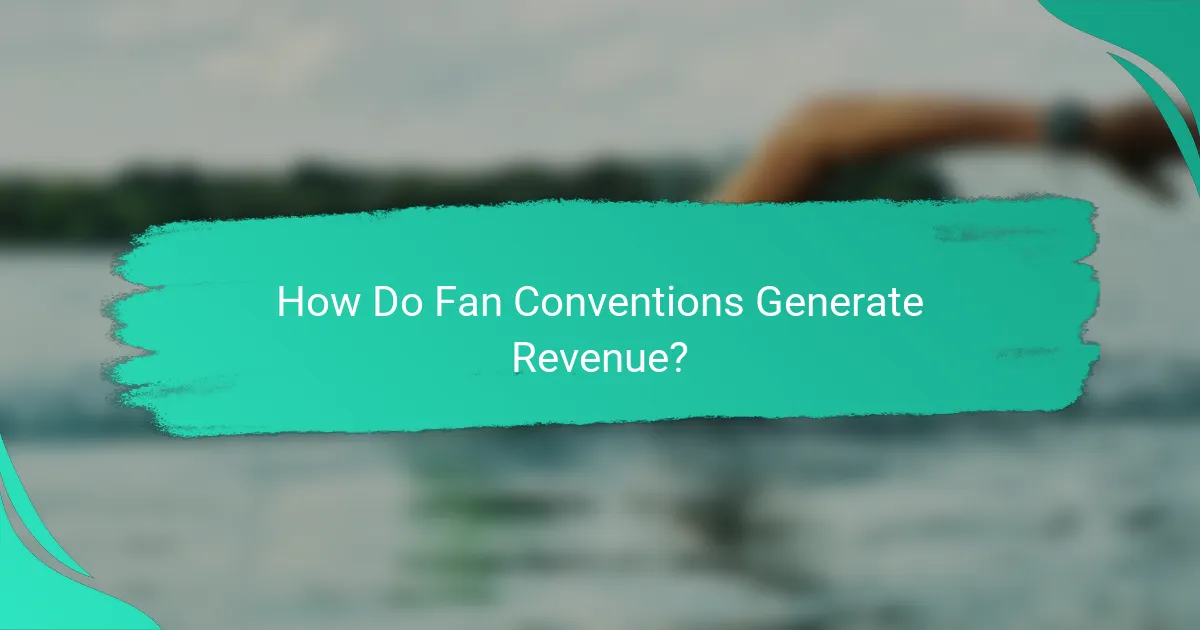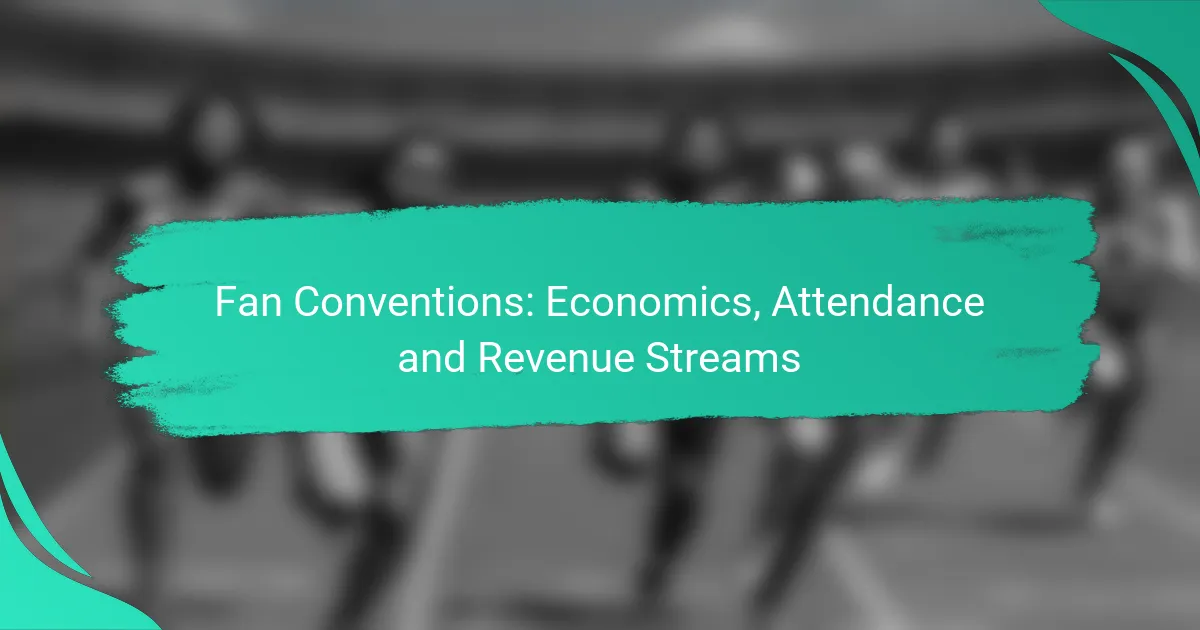Fan conventions serve as vibrant hubs for enthusiasts, generating substantial revenue through diverse streams such as ticket sales, sponsorships, and merchandise. Attendance is shaped by factors like location, guest appearances, and marketing strategies, all of which are vital for maximizing turnout. Moreover, these events contribute significantly to local economies, benefiting various sectors and creating a ripple effect of economic activity.

How Do Fan Conventions Generate Revenue?
Fan conventions generate revenue through multiple streams, including ticket sales, sponsorships, merchandise, vendor fees, and fees for panels and workshops. Each of these revenue sources plays a crucial role in the financial viability of the event.
Ticket sales
Ticket sales are often the primary source of revenue for fan conventions. Prices can vary widely, typically ranging from around $20 to several hundred dollars depending on the event’s scale and the included perks, such as VIP access or exclusive merchandise.
To maximize ticket sales, organizers should consider tiered pricing strategies, offering early bird discounts or group rates. This approach can incentivize attendees to purchase tickets in advance, helping to secure funds before the event.
Sponsorship deals
Sponsorship deals provide another significant revenue stream for fan conventions. Companies often pay to have their brands featured prominently at events, which can include logo placements, booths, or sponsored panels.
When negotiating sponsorships, it’s essential to identify potential partners that align with the convention’s theme and audience. Offering various sponsorship packages can attract a wider range of sponsors, from local businesses to larger corporations.
Merchandise sales
Merchandise sales can significantly boost a convention’s revenue. This includes everything from branded apparel to exclusive collectibles that appeal to fans. Offering unique items that cannot be found elsewhere can drive sales and enhance the overall experience.
Organizers should consider collaborating with artists or creators to produce limited-edition merchandise, which can create buzz and encourage attendees to make purchases during the event.
Vendor fees
Charging vendors for booth space is a common practice at fan conventions. Vendors typically pay fees to sell their products, which can range from a few hundred to several thousand dollars based on location and foot traffic potential.
To attract quality vendors, it’s important to curate a diverse lineup that complements the convention’s theme. Providing amenities like electricity, Wi-Fi, and promotional support can make vendor participation more appealing.
Panel and workshop fees
Fees for panels and workshops can also contribute to a convention’s revenue. Some events charge attendees to participate in specialized sessions led by industry experts or popular figures in the fandom.
When planning these sessions, organizers should ensure that the content is engaging and relevant to the audience. Offering a mix of free and paid sessions can cater to different attendee budgets while still providing valuable experiences.

What Factors Influence Attendance at Fan Conventions?
Attendance at fan conventions is influenced by a variety of factors including location, guest appearances, marketing strategies, and timing. Understanding these elements can help organizers maximize turnout and enhance the overall experience for attendees.
Location and accessibility
The location of a fan convention plays a crucial role in determining attendance. Events held in major cities or areas with good transportation links tend to attract more visitors. Accessibility for individuals with disabilities is also important, as it can impact the willingness of potential attendees to participate.
Consider the proximity of hotels, public transport options, and parking facilities when selecting a venue. A convention center in a vibrant area may encourage more foot traffic and engagement compared to a remote location.
Guest appearances
High-profile guests, such as popular actors, authors, or artists, can significantly boost attendance at fan conventions. Fans are often willing to travel long distances to meet their favorite personalities, making guest line-ups a key marketing point.
Organizers should aim to secure a diverse range of guests that appeal to different fandoms. Offering exclusive panels or meet-and-greet opportunities can further enhance the attractiveness of the event.
Marketing strategies
Effective marketing strategies are essential for driving attendance at fan conventions. Utilizing social media platforms, email newsletters, and partnerships with influencers can help reach a wider audience. Engaging content, such as sneak peeks or behind-the-scenes looks, can generate excitement.
Consider offering early bird ticket pricing or group discounts to incentivize early purchases. Clear communication about the event’s unique features can also help attract potential attendees.
Timing and scheduling
The timing of a fan convention can greatly influence attendance. Events scheduled during school holidays or long weekends typically see higher participation rates. Additionally, avoiding clashes with major holidays or other large conventions can help maximize turnout.
Organizers should also consider the duration of the event. A well-structured schedule that includes a mix of panels, workshops, and social events can keep attendees engaged throughout the convention.

How Do Fan Conventions Impact Local Economies?
Fan conventions significantly boost local economies by attracting visitors and generating revenue for businesses. These events create a ripple effect, benefiting various sectors from hospitality to retail.
Increased tourism
Fan conventions draw attendees from various regions, often resulting in increased tourism for the host city. Visitors typically spend on accommodations, dining, and local attractions, which can lead to a substantial influx of cash into the local economy.
For instance, a large convention can attract thousands of attendees, contributing millions in tourism revenue over a weekend. Cities often see hotel bookings spike, with rates rising due to demand during these events.
Local business revenue
Local businesses, especially those in hospitality and retail, experience a significant boost during fan conventions. Restaurants, shops, and entertainment venues often report increased sales, as attendees seek food, merchandise, and experiences related to the convention.
Merchandise sales can see a notable uptick, with local vendors capitalizing on the event’s theme. For example, a comic convention may lead to increased sales in comic shops and themed cafes, benefiting the local economy further.
Job creation
Fan conventions can lead to temporary and permanent job creation in the host city. Event staffing, security, and hospitality roles often expand to accommodate the influx of visitors, providing short-term employment opportunities.
In the long term, successful conventions can encourage businesses to hire more staff year-round, as they prepare for future events. This growth can enhance the local job market and contribute to economic stability in the area.

What Are the Key Demographics of Fan Convention Attendees?
Fan convention attendees typically range across various age groups, interests, and geographic locations. Understanding these demographics is crucial for organizers and exhibitors to tailor their offerings and marketing strategies effectively.
Age groups
Fan convention attendees often span a wide range of age groups, with a significant concentration among young adults aged 18-34. However, conventions also attract families and older fans, including those aged 35-54, who may have grown up with the franchises represented. This diversity in age can influence programming, merchandise, and activities offered at the event.
Organizers should consider age-specific interests when planning events, such as panels or workshops that appeal to different generations. For instance, younger attendees might prefer interactive experiences, while older fans may appreciate nostalgia-driven content.
Interests and fandoms
Attendees at fan conventions often share a passion for specific interests, including comic books, movies, television shows, video games, and anime. These fandoms can significantly shape the convention’s atmosphere and programming, as fans are eager to engage with their favorite franchises and creators.
Understanding the predominant interests can help organizers curate relevant panels, merchandise, and guest appearances. For example, a convention focused on science fiction may feature more panels on technology and storytelling, while one centered on anime might include cosplay contests and art workshops.
Geographic distribution
Fan conventions attract attendees from various geographic locations, often drawing a local crowd as well as fans traveling from other regions or countries. Major cities tend to host larger conventions due to better accessibility and infrastructure, while smaller events may cater to local fandoms.
Organizers should consider the geographic distribution of their attendees when planning logistics, marketing, and partnerships. For instance, conventions in the U.S. may need to account for travel costs and accommodations for international fans, while European conventions might focus on regional interests and languages.

How Do Virtual Fan Conventions Compare to In-Person Events?
Virtual fan conventions often offer a more accessible and cost-effective alternative to in-person events. While both formats have their unique benefits, virtual conventions can eliminate travel expenses and venue costs, making them appealing to a broader audience.
Cost-effectiveness
Virtual fan conventions typically incur lower costs than in-person events. Organizers save on venue rentals, staffing, and logistics, which can significantly reduce overall expenses. Attendees also benefit from this cost-effectiveness, as they avoid travel, accommodation, and food expenses, allowing participation from a wider demographic.
For example, while an in-person convention might charge attendees upwards of $100 for a ticket, a virtual ticket could be priced at a fraction of that, often between $10 to $50. This pricing strategy can lead to higher attendance numbers and increased overall revenue.
Audience reach
Virtual fan conventions can attract a global audience, breaking geographical barriers that limit in-person events. This expanded reach allows fans from various countries to participate without the need for travel, significantly increasing potential attendance.
In contrast, in-person conventions are often limited to local or regional attendees, which can restrict their audience size. For instance, a convention held in the United States may only draw attendees from North America, whereas a virtual event can engage fans from Europe, Asia, and beyond, maximizing exposure and interaction.
